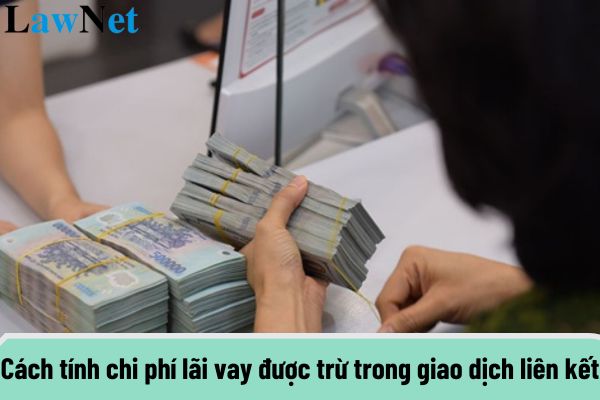How to calculate deductible loan interest costs in related-party transactions for PIT calculation in Vietnam?
How to calculate deductible loan interest costs in related-party transactions for PIT calculation in Vietnam?
Pursuant to points a and b, clause 3, Article 16 of Decree 132/2020/ND-CP, which stipulates the determination of costs for tax calculation for enterprises with related-party transactions for PIT calculation as follows:
Determination of costs for tax calculation for enterprises with related-party transactions
...
3. Total deductible loan interest costs when determining the taxable income of enterprises with related-party transactions:
a) Total loan interest costs after subtracting interest from deposits and loans arising during the tax period of the taxpayer are deductible when determining the taxable income of the enterprise, which do not exceed 30% of the total net profit from business activities during the tax period plus loan interest costs after subtracting interest from deposits and loans arising during the period plus depreciation costs arising during that taxpayer's period;
b) The non-deductible portion of loan interest costs under point a of this clause may be transferred to the following tax period when determining the total deductible loan interest costs, provided the total deductible loan interest incurred in the subsequent tax period is less than what is stipulated at point a of this clause. The duration of transferring loan interest costs is continuous and not exceeding 5 years from the year following the year the non-deductible loan interest costs arise;
...
In summary, according to the above regulations, the deductible loan interest cost in related-party transactions for CIT calculation is determined as follows:
- Total loan interest costs, after subtracting interest from deposits and loans arising during the period of the taxpayer, are deductible when determining taxable income for CIT, which do not exceed 30% of the total net profit from business activities during the tax period plus loan interest costs after subtracting interest from deposits and loans arising during the period plus depreciation costs arising during that period for the taxpayer.
- The portion of non-deductible loan interest costs will be transferred to the following tax period to determine the total deductible loan interest costs if the total deductible loan interest incurred for the subsequent tax period is less than 30% of the total net profit from business activities during the period plus loan interest costs after subtracting interest from deposits and loans arising during the period plus depreciation costs incurred during the period by the taxpayer.
The transfer period of loan interest costs is continuous and not exceeding 5 years from the year following the year the non-deductible loan interest costs arise.
Note: The aforementioned deductible loan interest costs in related-party transactions do not apply to loans of taxpayers who are: credit institutions, insurance business organizations, loans supported by official development assistance (ODA), concessional loans from the Government of Vietnam, loans for national target programs, and loans for investment programs or projects implementing the state's social welfare policies.

How to calculate deductible loan interest costs in related-party transactions for PIT calculation in Vietnam? (Image from the Internet)
What are cases where taxpayers are exempt from declaring and preparing transfer pricing declaration in Vietnam?
Pursuant to Article 19 of Decree 132/2020/ND-CP, it stipulates the cases in which taxpayers are exempt from declaring and preparing transfer pricing declaration as follows:
- Taxpayers are exempt from declaring the determination of transfer pricing at Section III, Section IV Annex I issued with Decree 132/2020/ND-CP, and exempt from preparing transfer pricing declaration according to the regulation in this Decree if transactions arise only with related parties that are subject to corporate income tax in Vietnam, applying the same corporate income tax rate as the taxpayer, and none receives preferential corporate income tax during the tax period. However, they must declare the grounds for exemption at Section I, Section II of Annex I issued with Decree 132/2020/ND-CP.
- Taxpayers have the responsibility to declare the determination of transfer pricing according to Annex I issued with Decree 132/2020/ND-CP, but are exempt from preparing transfer pricing declaration in the following cases:
+ Taxpayers have related-party transactions but the total revenue arising in the tax period is below VND 50 billion and the total value of all related-party transactions in the tax period is below VND 30 billion;
+ Taxpayers have entered into Advance Pricing Arrangements and submit Annual Reports according to legal regulations on Advance Pricing Arrangements. Related-party transactions not covered by the Advance Pricing Arrangement, taxpayers must still declare the determination of transfer pricing according to regulations at Article 18 of Decree 132/2020/ND-CP.
- Taxpayers engaged in business with simple functions, not incurring revenue, and expenses from the exploitation or use of intangible assets, with revenue below VND 200 billion, applying a profit margin before interest and corporate income tax (excluding differences in financial revenue and expenses) on net revenue, including the following sectors:
- Distribution: from 5% and above;
- Production: from 10% and above;
- Processing: from 15% and above.
In cases where taxpayers track and account for revenue and expenses separately by sector, apply the profit margin before interest and corporate income tax on net revenue applicable to each sector. In cases where taxpayers track and account for revenue separately but not expenses for each field of production and business, allocate expenses according to the revenue proportion of each field to apply the profit margin before interest and corporate income tax on net revenue applicable to each sector.
In cases where taxpayers neither track nor account for revenue and expenses separately by each field of their production and business activities to determine the profit margin before interest and corporate income tax applicable to each sector, apply the profit margin before interest and corporate income tax on net revenue from the sector with the highest profit margin.
In cases where taxpayers do not apply profit margins according to this regulation, they must prepare transfer pricing declaration as specified.
- Taxpayers are eligible for exemption from declaring, preparing transfer pricing declaration according to clause 1, clause 2 of Article 16 of Decree 132/2020/ND-CP. The determination of the total deductible loan interest costs for determining taxable corporate income of enterprises with related-party transactions is performed pursuant to clause 3, Article 16 of Decree 132/2020/ND-CP.
What are related-party transactions?
Pursuant to clause 22, Article 3 of the Law on Tax Administration 2019, related-party transactions are defined as follows:
Interpretation of terms
...
22. Related-party transaction is a transaction between parties with a relationship.
23. Independent transaction is a transaction between parties without a relationship.
...
Thus, according to the above regulations, a related-party transaction is a transaction between parties that have a relationship.

